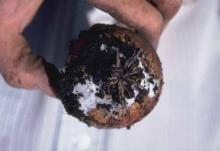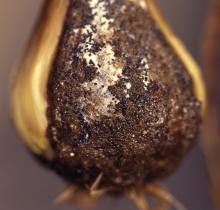Cause A fungus, Sclerotium cepivorum (teleomorph: Stromatinia cepivora), that produces hardy sclerotia, which may survive in soil for 20 to 30 years. Only Allium spp. such as onion, leek, and shallot are attacked. Sclerotia can infect plants from 12 inches below the soil surface. One sclerotium can infect a group of 20 to 30 adjacent plants. Fungal activity is favored by cool soils and is restricted above 75°F. Once the disease is in a field, it is very difficult to grow Allium spp. successfully. Disease spreads with infected sets or transplants, grazing animals, and movement of infested soil.
Symptoms Leaves decay at the base, turn yellow, wilt, and topple over. Older leaves collapse first. Roots rot, and the plant can be pulled up easily. Fluffy mycelium may be on remaining roots and bulb. Affected bulbs may become watery, and outer scales crack as they dry and shrink. Small sclerotia (0.02 inch, or about the size of a poppy seed) form in and on the surface of affected bulb parts, often around the neck. White rot can continue to decay infected bulbs in storage if humidity is not kept low.
Cultural control Idaho, Oregon, and Washington laws forbid importing bulbs or other material infected with white rot into some areas of each state.
- Plant only pathogen-free material in pathogen-free soil.
- Avoid moving sclerotia-contaminated soil into new fields by washing equipment before it enters another field.
- If practical, dig out all plants in infested spots in the field and the healthy plants growing next to diseased ones. Remove some soil with both diseased and healthy plants. Dispose of the material in a landfill or hot composting operation.
Chemical control When soil in the top several inches remains above 75°F for at least part of the day through much of the growing season, fungicides will help to manage white rot. Under cooler soil conditions, the disease is only partly controlled even with the best chemical controls, and areas with cool soil conditions frequently become useless for producing all Allium spp.
- Treating heavily infected areas of organic soils with tarped fumigation has helped reduce inoculum in infested fields but may not provide sufficient control when used alone.
- Botran 75 W (Group 14) at 5.33 lb/A. Do not apply more than once per season, or use a spreader-sticker, or rotate to spinach after harvest. 12-hr reentry.
- Cannonball WG (Group 12) at 7 oz/A (0.5 oz/1,000 ft row) applied as an in-furrow application prior to seed placement. 12-hr reentry.
- Demethylation-inhibiting (DMI) fungicides (Group 3) are labeled for use.
- Tebustar 3.6L at 20.5 oz/A applied in a 4- to 6-inch band. Preharvest interval is 7 days. 12-hr reentry.
- Tebuzol 3.6F at 20.5 oz/A applied in a 4- to 6-inch band. Do not apply within 7 days of harvest. 12-hr reentry.
- Fontelis (Group 7) at 16 to 24 fl oz/A on 7- to 14-day intervals and at 1.2 to 1.6 fl oz/1,000 row foot as a soil application. Do not make more than two (2) sequential applications before alternating to a labeled fungicide with a different mode of action (non-Group 7). Preharvest interval is 3 days. 12-hr reentry.
- Miravis Prime (Group 7 + 12) at 10.3 to 11.4 fl oz/A on 7-day intervals. Do not make more than two (2) sequential applications before alternating to a labeled fungicide with a different mode of action. Preharvest interval is 7 days. 12-hr reentry.
- Quilt Xcel (Group 11 + 3) at 17.5 to 21 fl oz/A on a 7- to 10-day interval. Do not apply more than one (1) application before rotating to a non-Group 11 fungicide. May be applied the day of harvest for green onion types; 14-day preharvest interval for dry bulb onions. 12-hr reentry.
- Switch 62.5 WG (Group 9 + 12) at 7 to 14 oz/A at time of planting as an in-furrow spray. 12-hr reentry.
- Topsin M 70 WP (Group 1) at 0.33 to 0.5 lb/1,000 row feet as a spray directly into the furrow at planting. Do not use through any irrigation system. 12-hr reentry.
Reference Schwartz, H.F., and Mohan, S.K. 1995. Compendium of Onion and Garlic Diseases. St. Paul, MN: APS Press.



